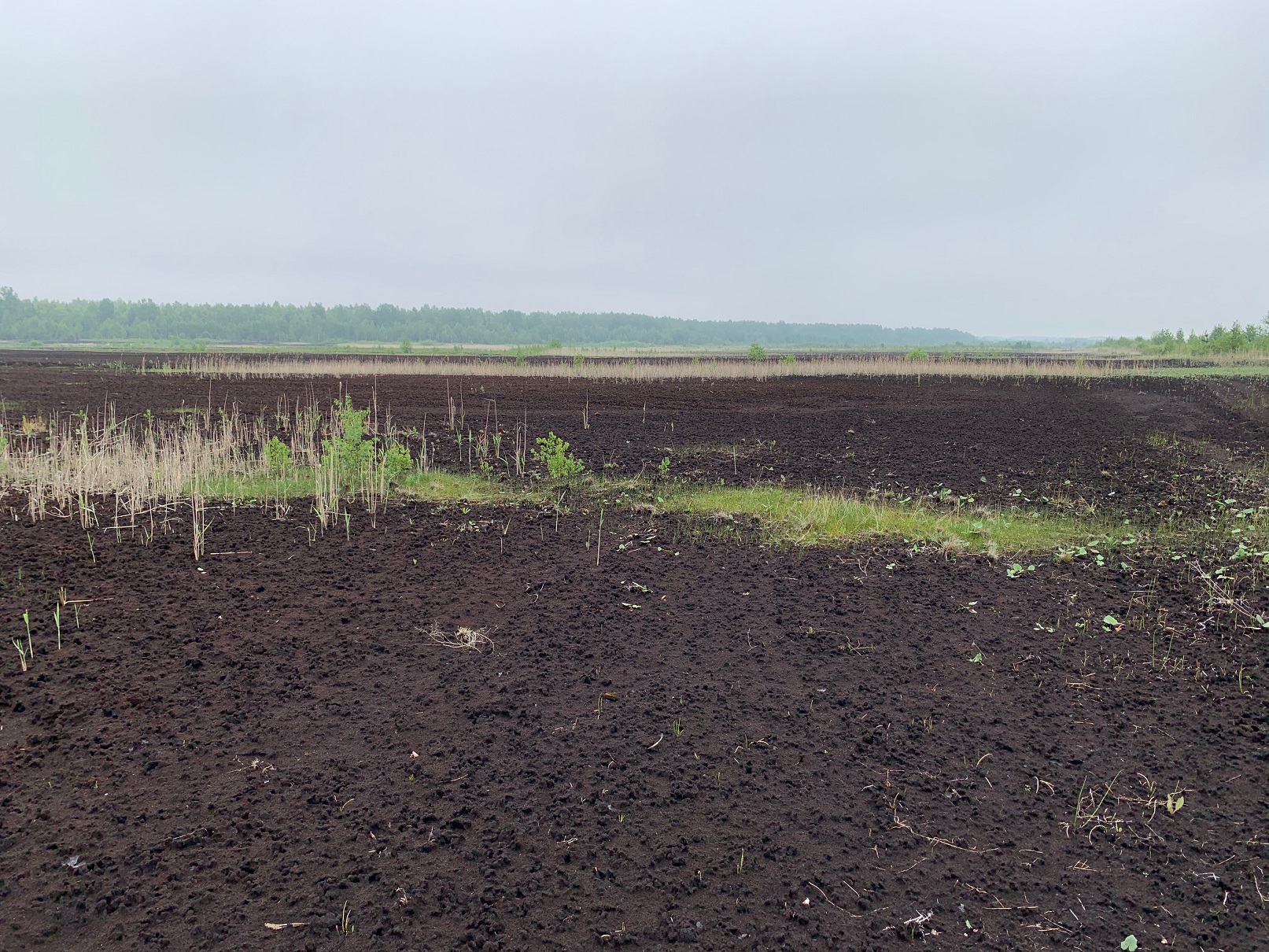The area affected by drainage may be 20–150% larger than the peat extraction area
Before the 1950s, peat was mined by hand from the edges of bogs in Estonia, and the extensive drainage known today was not done – that is why these areas recovered quickly and the impact on biodiversity was small. Since the 1950s, large-scale peat fields have been created as a result of the introduction of milling technology, which has led to the significant destruction of biodiversity in these areas [1].
In 2018, 962.8 thousand tons of peat were mined in Estonia, and the mining volume increased by 42%, compared to 2017, for example. Peat was mainly used in horticulture and as a heating material [2]. The construction of a peat mine first starts with the removal of existing vegetation down to a layer of peat suitable for extraction. In the process, plant species (such as peat mosses) are destroyed. Then, the drainage ditches are built, which cause changes in the composition of plant species in neighbouring areas even decades later [3].
The area affected by the drainage may be 20–150% larger than the peat extraction area [4]. Drainage has the strongest effect at a distance of up to about 100 m from the drainage ditch [5]. A study carried out in the Elbu bog found that drainage also reduced the number of nesting birds in neighbouring areas [4].
In non-drained mires, more peat is formed than decomposed because the access to oxygen is blocked due to excessive moisture. As a result of climate change, the formation of peat in Estonian natural bogs will increase and our bogs will begin to capture more carbon [6]. However, when the peat areas are drained, access to oxygen is ensured and the peat begins to decompose. As a result, a number of greenhouse gases are released into the atmosphere: carbon dioxide (CO2), nitrous oxide (N2O), and methane (CH4) [7]. In Estonia, the largest emitter of CO2 is the oil shale industry, followed by peat mining areas, which contribute significantly to the amount of greenhouse gases and thus affect the climate [8]. For example, the emission of CO2 from the road transport industry is nine times smaller than that of the peat mining areas [9].

Text: Kristjan Piirimäe, Kuno Kasak
Editors: Sigrid Ots, Reigo Roasto
Last modified: 13.01.2022
__________________________________________________
[1] E. Karofeld. Turbakaevandamisest tekkinud keskkonnakahjulike soode korrastamine vähendab kasvuhoonegaaside eraldumist. Novaator, 2015. https://novaator.err.ee/258083/turbakaevandamisest-tekkinud-keskkonnakahjulike-soode-korrastamine-vahendab-kasvuhoonegaaside-eraldumist
[2] R. Roosalu. Eesti Vabariigi 2018. aasta maavarude koondbilansid (seisuga 31.12.2018). Maa-amet. https://geoportaal.maaamet.ee/docs/geoloogia/koondbilanss_2018_seletuskiri.pdf?t=20190522133534
[3] H. Trass. Fen flora and vegetation status in Estonia. – In: Proceedings of the International Symposium Conservation and Management of Fens. Falenty Agricultural University, Faculty of Land Reclamation, Institute of Land Reclamation and Grassland Farming, 6–10 June 1994, Warsaw–Biebrza, pp. 467-475.
[4] T. Tali. Turbakaevanduse mõju soos pesitsevate kahjaliikide arvukusele ja liigilisele koosseisule 1959.–2017. aastatel Lavassaare soostikus. Magistritöö. Eesti Maaülikool, 2019. http://dspace.emu.ee/xmlui/bitstream/handle/10492/4879/Tiiu_Tali_2019MA_LM
_t%c3%a4istekst.pdf?sequence=1&isAllowed=y
[5] A. Kull. Soode ökoloogilise funktsionaalsuse tagamiseks vajalike puhvertsoonide määratlemine pikaajaliste häiringute leviku piiramiseks või leevendamiseks. Käsikiri Tartu Ülikooli Ökoloogia ja Maateaduste Instituudis, 2013.
[6] A. Gallego-Sala, A. Korhola, A. Väliranta, M. M. Latitudinal limits to the predicted increase of the peatland carbon sink with warming. Nature Climate Change, 2018, 8(10), 907-914. https://www.nature.com/articles/s41558-018-0271-1.pdf
[7] J.-O. Salm, K. Soosaar, M. Maddison, S. Tammik, Ü. Mander. Kasvuhoonegaasid ja süsinikukaod Eesti soodest. Eesti Loodus, 9/2010. http://www.eestiloodus.ee/artikkel3455_3441.html
[8] T. Triisberg. Factors influencing the re-vegetation of abandoned extracted peatlands in Estonia. Doktoritöö. Tartu Ülikool, 2014. https://dspace.emu.ee/xmlui/bitstream/handle/10492/4207/Palmist_%20Marilin_%20KK_bak_2018_
t%C3%A4istekst.pdf?sequence=1&isAllowed=n
[9] M. Ilomets. Mis saab jääksoodest? Eesti Loodus, 6/2010, 218–221. http://vana.loodusajakiri.ee/eesti_loodus/EL/vanaweb/0106/mati.html